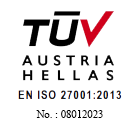How night vision works:
Night vision profits of any small amount of light in the surrounding area (such as moonlight or starlight), and converts the light energy (photons), into electrical energy (electrons). In the image intensifier "tube," photons enter the photocathode, which in turn releases electrons. These electrons pass through a thin disk (a micro-channel plate), about the size of a coin with over 6 million channels. As the electrons pass through the channels, they strike on the channel walls, which, in turn, release more electrons. By the time the electrons exit the micro-channel plate, they have been multiplied by thousands of times. The multiplied electrons then are then accelerated onto a phosphor screen (similar to television). Electrons strike on the screen, and the phosphor "glows" in the same pattern as the light (photons), which originally entered the photocathode. The user then sees the brightened intensified image in a way similar to someone "watching" a TV screen.
Night Vision Systems Generations
Generation:
It uses technology dependent on ambient light to increase the available light energy. Following the transformation of light to electrons, special electronic devises make those electrons focus on a conical apparatus (anodic tube) and accelerate them to strike against a phosphoric screen with greater energy, thus creating an image in the visual spectrum. Unfortunately, accelerating electrons through this method creates idol distortions and reduces the cathode tube life expectancy.
It uses better materials compared to those of generation "0" to divert transform light into electrons. This generation's devises are capable of functioning with lower light levels, and are known as "star light multipliers". But idol distortions and reduced life expectancy problems also remain in this generation.
This generation\'s characteristic is the development of a micro-channel disk, which multiplies the number of electrons by a factor of thousands. The result is a clear idol without the distortions encountered in previous generations.
It constitutes the most advanced technology. Photocathode is coated with an extremely sensitive material, which allows more effective transformation of light into electrical energy in very low levels of ambient light.
Night Vision Goggles (NVG's)
Night Vision Goggles (NVGs) AN / ANSAVS-6 (V)1 and (V)2 are self-powered night vision devises, which provide with the ability of night vision enhancement using night sky\'s ambient light [moon, stars, light deflection (sky\'s light emission) etc.
TADS/PNVS
TADS (Target Acquisition Sight - AN / ASQ - 170)is placed into the nose mount of the AH-64 Apache helicopter and provides optical, remote and 3-field infrared forward depiction (Forward Looking Infra Red - FLIR), in order to conduct research, acquisition and reconnaissance. It disposes also a range-meter and a laser-pointer. PNVS (Pilot Night Vision Sensor -AN / AAQ - 11) consists of a FLIR system placed in a rotating mount over TADS. Image from PNVS is projected in a monocular eyepiece, a part of the advanced HADDS (Helmet And Display Sighting System) system, in the helmets of the Pilot in Command and the Co-pilot / Gunner.
The combination of those 2 systems, which can be installed and operated independently, enables Apache pilots to fly in very low height, in total darkness and in adverse weather conditions, to recognise targets on the ground and to destroy them in standoff distances.


